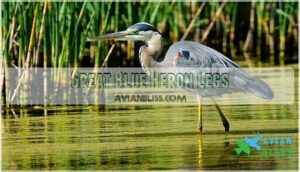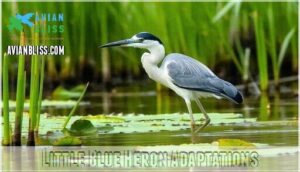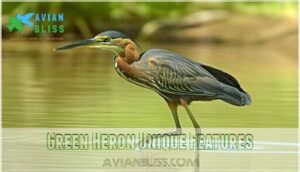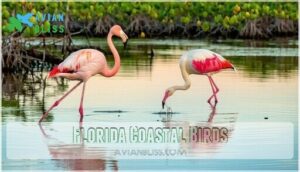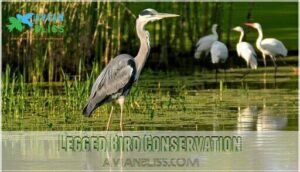This site is supported by our readers. We may earn a commission, at no cost to you, if you purchase through links.
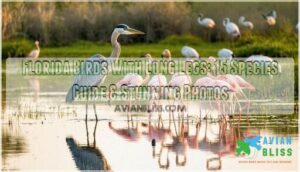
These stilted wonders include egrets, herons, spoonbills, and even flamingos, each sporting legs that work like nature’s fishing poles.
Their extended limbs let them wade deeper into marshes and shallow waters without soaking their feathers, giving them access to fish, frogs, and crustaceans that shorter-legged birds can’t reach.
Think of them as Florida’s feathered fishing fleet, perfectly equipped for wetland life.
Each species has developed unique hunting strategies and habitat preferences that make spotting them an exciting challenge.
Table Of Contents
- Key Takeaways
- Florida Wading Birds
- Heron Species Overview
- Birds With Distinct Legs
- Florida Coastal Birds
- Legged Bird Conservation
- Frequently Asked Questions (FAQs)
- What birds live in Florida?
- What birds have long legs?
- What bird has red legs?
- What is a long-legged bird known for?
- Is Florida a bird-friendly state?
- Where do long-legged birds live in North America?
- What are the big birds with long legs in Florida?
- What are the 4 foot birds in Florida?
- Why are sandhill crane illegal in Florida?
- What is the difference between an egret and a great egret?
- Conclusion
Key Takeaways
- You’ll find fifteen different species of long-legged wading birds throughout Florida’s wetlands, including Great Blue Herons, Snowy Egrets, Roseate Spoonbills, and even American Flamingos, each perfectly adapted for hunting in shallow waters.
- You can identify these birds by their distinctive leg colors and patterns – Great Blue Herons have yellow-green legs, while their extended limbs allow them to wade deeper than shorter-legged birds without soaking their feathers.
- You’ll spot these birds using unique hunting strategies in diverse habitats, from saltwater marshes to freshwater lakes, where they feed on fish, frogs, crustaceans, and aquatic insects using their specialized beaks and patient stalking techniques.
- You can help protect Florida’s long-legged birds by supporting wetland conservation programs and reporting unusual bird deaths, as these species face serious threats from habitat loss, pollution, and climate change that require ongoing conservation efforts.
Florida Wading Birds
You’ll find Florida’s wading birds among the most recognizable long-legged species, with their elegant necks and specialized beaks perfectly adapted for hunting in shallow waters.
These birds, including Great Egrets, Snowy Egrets, and various heron species, use their impressive height to wade through marshes, lakes, and coastal areas while searching for fish, frogs, and other aquatic prey, which makes them a fascinating sight due to their elegant necks.
Florida’s majestic wading birds transform wetlands into living galleries with their graceful hunting displays.
Great Egret Characteristics
You’ll spot Great Egrets throughout Florida’s wetlands, thanks to their impressive global range spanning nearly all continents.
These majestic florida wading birds stand out among long legged birds with their striking features:
- White plumage transforms with ornamental breeding plumage during mating season
- Distinctive yellow beak paired with black legs creates perfect identification markers
- Habitat variety includes both saltwater and freshwater environments
- Conservation status remains stable due to successful protection efforts
The combination of these characteristics, including their striking features and ability to thrive in various habitats, makes them a notable species in Florida’s ecosystems, with a stable presence.
Snowy Egret Habitat
You’ll find Snowy Egrets thriving in Florida’s diverse wetland habitats, from saltwater marshes to freshwater lakes.
These elegant waders transform Florida’s shallow waters into their personal hunting grounds, showcasing nature’s perfect design.
These elegant wading birds prefer shallow waters where prey abundance supports their fishing lifestyle.
Water quality directly impacts their success, as clean environments sustain the small fish and crustaceans they need.
They often require specific dietary food products to maintain peak health.
| Habitat Type | Water Depth | Prey Available | Nesting Preference | Season Present |
|---|---|---|---|---|
| Coastal Wetlands | 6-18 inches | Fish, crabs | Colony trees | Year-round |
| Freshwater Marsh | 4-12 inches | Frogs, insects | Mangroves | Year-round |
| Shallow Lakes | 8-20 inches | Minnows, shrimp | Cypress trees | Year-round |
| Tidal Pools | 2-8 inches | Small crabs | Nearby rookeries | Year-round |
| Storm Ponds | 6-15 inches | Tadpoles, fish | Isolated trees | Seasonal |
They are found in various habitats, including coastal wetlands, freshwater marsh, shallow lakes, tidal pools, and storm ponds, each with its unique characteristics and offerings.
Cattle Egret Migration
You’ll notice Cattle Egrets typically arrive in Florida between March and April, following established migratory routes from Central America and the Caribbean.
Their range expansion across the Americas showcases remarkable breeding success, with these adaptable florida shorebirds using their long legs to navigate diverse wetland habitats.
This habitat impact transforms local ecosystems as florida birds establish new colonies during bird migration seasons, which is a result of their remarkable adaptability.
Heron Species Overview
You’ll encounter five distinctive heron species throughout Florida’s wetlands, each with unique characteristics that make Heron Identification rewarding.
Great Blue Heron stands tallest with its impressive six-foot wingspan and blue-gray plumage, while Little Blue Heron adults display slate-blue coloring that contrasts sharply with their white juvenile phase.
Green Heron prefers smaller waterways, showing olive-green bodies and secretive nature.
Tricolored Heron sports striking blue-gray upperparts with a bright white belly stripe.
These herons occupy diverse Heron Habitats from saltwater marshes to freshwater lakes.
Their Heron Diets vary substantially – Great Blue Heron tackles fish and small mammals, while Green Heron focuses on smaller prey.
Understanding Heron Behavior helps with identification, as each species displays distinct hunting techniques and territorial patterns.
Heron Conservation efforts have successfully protected these magnificent wading birds, ensuring stable populations across Florida’s ecosystems for future generations to enjoy.
Birds With Distinct Legs
You’ll notice that Florida’s long-legged birds have developed remarkable leg features that help you identify each species in the field.
These distinct leg characteristics, from color patterns to unique adaptations, serve as reliable field marks that make bird identification easier when you’re exploring Florida’s wetlands.
Great Blue Heron Legs
The Great Blue Heron’s leg length serves as a remarkable hunting adaptation, allowing these Florida birds to wade deeper than other wading birds.
Their sturdy yellow-green leg coloration provides perfect camouflage in marsh environments.
This balance mechanism offers evolutionary advantage – you’ll notice their long legs fold horizontally during flight, distinguishing them from similar species.
You can even find Great Blue Heron products online, which is a great way to support the conservation of these amazing Florida birds with unique leg coloration.
Little Blue Heron Adaptations
You’ll spot Little Blue Heron’s remarkable juvenile plumage transformation – white youngsters gradually develop slate-blue adult coloring.
Their feeding strategies include patient stalking and quick strikes in shallow waters.
These Florida birds with long legs excel at habitat selection, choosing freshwater marshes over saltwater areas.
You can even find Little Blue Heron products online.
Their breeding behavior involves colonial nesting, while conservation status remains stable throughout their range.
Green Heron Unique Features
You’ll easily recognize the Green Heron by its distinctive olive-green body and striking black wing color.
This compact wading bird species stays remarkably quiet throughout the day, but listen for its sharp "kreee" Green Heron call during dusk/dawn activity periods.
Unlike other Florida birds with long legs, Green Herons prefer solitary nesting habits near secluded water sources.
Florida Coastal Birds
You’ll find Florida’s coastal waters teeming with spectacular long-legged birds that have mastered life between land and sea.
These salt-tolerant species, including the iconic American Flamingo and the distinctive Roseate Spoonbill, showcase remarkable adaptations that help them thrive in Florida’s unique coastal ecosystems.
American Flamingo Habitat
American Flamingo populations in Florida likely stem from Zoo Escapees rather than natural colonization.
You’ll find these striking wading bird species in Salt Flat environments, brackish marshes, and shallow coastal lagoons throughout the Everglades.
Their Population Origins remain debated, but over 95% of Florida birds concentrate in the Everglades, Biscayne Bay, and Florida Keys, where Everglades Colonization continues expanding their range.
Roseate Spoonbill Diet
You’ll find Roseate Spoonbills sweeping their distinctive spatula-shaped bills through shallow waters, filtering small fish, crustaceans, and aquatic insects.
Their bill morphology allows efficient spoonbill foraging in muddy bottoms.
Crustacean consumption directly affects their pink coloration through dietary pigments like carotenoids.
When prey availability decreases in one area, these Florida birds simply relocate to better feeding grounds along coastal marshes.
Tricolored Heron Behavior
While spoonbills sweep through shallow waters, Tricolored Herons showcase fascinating behavioral patterns.
You’ll witness their fierce territorial defense during breeding season, with males aggressively protecting feeding spots.
These Florida birds nest in colonies alongside other herons, displaying elaborate mating rituals with neck stretching and plume displays.
Juveniles follow parents closely, learning essential feeding strategies in coastal marshes.
Legged Bird Conservation
You can help protect Florida’s long-legged birds by supporting wetland conservation programs and reporting unusual bird deaths to wildlife authorities.
These magnificent waders face serious threats from habitat loss, pollution, and climate change, but your actions make a real difference in their survival.
Reddish Egret Population
You’ll find Reddish Egrets among Florida’s rarest long-legged birds, with only 5,000-7,000 individuals worldwide.
Their conservation status remains vulnerable despite protection since 1918.
These coastal habitat specialists display unique morph variations and hunting strategies that make florida bird identification exciting.
Texas hosts most breeding pairs, while Florida populations face future threats from habitat loss and climate change affecting their specialized behaviors.
Threats to Long-Legged Birds
While Reddish Egrets face challenges, they’re not alone.
Florida’s long-legged birds encounter mounting pressures from habitat loss as wetlands disappear for development.
Pollution impact degrades water quality, while climate change intensifies storms and droughts.
Invasive species compete for resources, and human disturbance disrupts nesting colonies, jeopardizing florida bird identification opportunities and endangered bird species across wetland habitats throughout the state.
Conservation Efforts in Florida
Throughout Florida’s wetland habitats, you’ll find dedicated bird conservation programs tackling climate change and invasive species threats.
The Florida Fish and Wildlife Conservation Commission partners with federal agencies to protect endangered bird species through habitat restoration projects.
Water quality improvements and public awareness campaigns help safeguard long-legged wading birds.
Your support for florida bird identification programs makes a real difference in conservation success.
Frequently Asked Questions (FAQs)
What birds live in Florida?
Like a living kaleidoscope, Florida’s skies showcase nature’s diversity.
You’ll spot majestic Great Blue Herons, snowy egrets, colorful Roseate Spoonbills, Purple Gallinules, Limpkins, and even introduced species like Common Mynas throughout the state’s varied habitats.
What birds have long legs?
Birds with long legs include herons, egrets, cranes, storks, and flamingos.
You’ll spot these wading birds in wetlands, where their extended limbs help them navigate shallow waters while hunting for fish and amphibians.
What bird has red legs?
Picture a traffic cone standing in wetland shallows – that’s what you’ll see with storks sporting bright red legs.
These wading birds use their crimson-colored limbs like natural stilts, perfectly adapted for traversing marshy waters while hunting.
What is a long-legged bird known for?
You’ll recognize long-legged birds for their incredible wading abilities in shallow waters, hunting fish and small prey with precision.
They’re also famous for their elegant flight patterns, holding legs stretched horizontally backward.
Is Florida a bird-friendly state?
Yes, you’ll find Florida’s incredibly bird-friendly!
With diverse wetlands, coastal areas, and year-round warmth, it hosts over 500 species including magnificent herons, egrets, spoonbills, and flamingos that thrive in its perfect habitat conditions.
Where do long-legged birds live in North America?
Though you might think they’re limited to wetlands, long-legged birds thrive across North America’s diverse habitats.
You’ll find herons in marshes, cranes in grasslands, stilts near coastlines, and flamingos in southern salt flats.
What are the big birds with long legs in Florida?
You’ll spot Great Blue Herons with six-foot wingspans, towering Great Egrets, and colorful Roseate Spoonbills in Florida’s wetlands.
These magnificent waders dominate marshes and coastal areas with their impressive size and striking appearances.
What are the 4 foot birds in Florida?
You’ll find Great Blue Herons reaching 4 feet tall, standing majestically in Florida’s wetlands.
These impressive waders hunt fish and small mammals while showcasing their distinctive blue-gray plumage and commanding 6-foot wingspan.
Why are sandhill crane illegal in Florida?
Sandhill cranes aren’t actually illegal in Florida.
You can hunt them during designated seasons with proper licenses and permits.
The confusion likely stems from strict regulations protecting these majestic birds outside hunting periods.
What is the difference between an egret and a great egret?
You’ll be absolutely amazed to discover that "egret" is actually the umbrella term for several white wading birds.
While "Great Egret" refers specifically to the largest species with its distinctive yellow beak and elegant black legs.
Conclusion
Like elegant sentinels standing guard over Florida’s watery kingdoms, these remarkable Florida birds with long legs represent nature’s perfect engineering.
You’ve discovered how each species uses its stilted advantage to thrive in wetland environments, from the Great Blue Heron’s patient hunting style to the Roseate Spoonbill’s unique feeding technique.
Next time you’re exploring Florida’s marshes, you’ll recognize these feathered fishermen and appreciate their essential role in maintaining healthy aquatic ecosystems throughout the Sunshine State.

